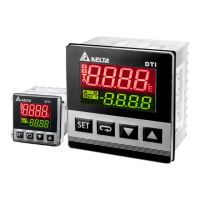
Do you have a question about the Delta DTI Series and is the answer not in the manual?
| Control Algorithm | PID, Auto-tuning |
|---|---|
| Series | DTI |
| Control Mode | PID, On-Off |
| Input | Thermocouple, RTD |
| Output | Relay |
| Display | LED |
| Power Supply | 24V DC, 100-240V AC |
| Communication | RS-485 |
| Dimensions | 96x96mm |
General safety warning for the controller and connected peripherals to prevent harm.
Warning against touching AC terminals while power is supplied to prevent electric shock.
Evaluate dangerous applications where serious injury or property damage may occur.
The controller requires an external switch or circuit-breaker for safety and operation.
Instructions on using solder-less terminals, preventing dust, avoiding interference, and proper wiring.
Features a high contrast LCD panel for easy monitoring and understanding.
100ms sampling time for fast external temperature measurement and response.
Shortened length of 60mm reduces installation space.
Conforms with CE international safety certification standards.
Explains how the controller measures temperature, processes data, and controls heating via outputs.
Describes the PV/SV display, LEDs (Celsius/Fahrenheit, Alarm, Mode), and pushbutton functions.
Details series, panel size, output options, and communication options for ordering.
Covers input voltage, power consumption, display method, sensor types, control modes, and output types.
Details alarm output type, display accuracy, sampling rate, vibration, shock, ambient temp, altitude, and humidity.
Explains the three modes: Operation, Regulation, and Initial Setting, and how to switch between them.
Lists parameters adjustable in Operation Mode, like RUN/STOP, decimal point, and alarm settings.
Lists parameters for initial setup, including input type, temperature unit, and limits.
Details the 9 alarm modes, including deviation, absolute value, and hysteresis alarms.
Explains how to set alarm delay, reverse, standby, and hold parameters.
How to change the PV and SV display unit to Celsius or Fahrenheit and set decimal points.
Setting the Set Value (SV) and configuring upper/lower input limits.
Adjusting filter factors and linear compensation for signal stability and accuracy.
How to check firmware version, output type, and input type during startup.
Selecting and configuring control modes for heating, cooling, or alarm outputs.
Describes the ON-OFF control logic for heating/cooling with adjustment sensitivity and dead band.
Explains PID operation, parameter setting, auto-tuning, and dual output control with Coef and DeadBand.
How to perform auto-tuning to automatically generate PID parameters for optimal control.
Setting maximum and minimum limits for control output percentages.
Configuring upper and lower limits for the input temperature range.
Procedure to restore the controller to its factory default settings.
How to lock/unlock the keypad and change the password.
Setting for disabling alarm functions.
Types 1-3 for deviation alarms based on PV relative to SV.
Types 4-6 for alarms based on absolute PV values against limits.
Types 7-8 for hysteresis alarms with ON/OFF switching points.
Type 9 for detecting sensor disconnection or incorrect connection.
How to set alarm mode, deviation limits, delay, reverse, standby, and hold.
Explains panel error codes like 'no', 'cont', 'SEn', 'Err' for sensor issues.
Provides panel cutout dimensions for 4848 and 9696 series controllers.
Step-by-step guide for installing the controller using mounting brackets for 4848 and 9696 series.
Illustrates wiring diagrams for 4848 and 9696 series and provides wiring precautions.
Information on where to find more temperature controller details and technical support.
